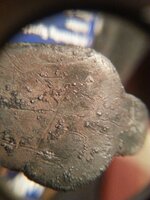testing123
Bronze Member
Got this a couple days ago at a muddy saltwater area. Now, the oldest find that can be dated previously is a later-date large cent (1841 or 1851, I forget). I don't know when the area first began use, but the surrounding towns were established in the 1600s and 1700s. Someone suggested it could date from the 1720s to 1740s. Is that an accurate date span? I read that these "trifid" spoons can date to the 1600s? Thanks for any help you can provide!











